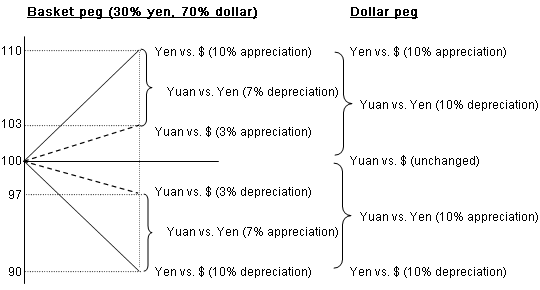The United States is calling on China to abandon its policy of pegging the yuan to the dollar and shift to a floating exchange rate regime. In response, China has said that the introduction of a more market-based flexible exchange rate system is a mid- to long-term goal. However, it is seeking more time, saying that prerequisites such as liberalization of trade and capital transactions and improvement in the soundness of its financial sector, such as its banks, have yet to fall into place. So long as a swift transition to a full-float system is impossible, China will likely adopt a managed float system that leaves room for active intervention by authorities during this long transition period. In setting up rules to manage the exchange rate, the so-called BBC method, which is comprised of three elements, namely, basket, band and crawling, is seen as a likely choice.
The basket system pegs a currency's exchange rate to a basket consisting of several currencies, rather than to one single currency like the dollar. The effective exchange rate, which reflects the weight of trade with a trading partner, can be considered a currency basket of sorts. Adopting a pegging system based on such a basket means that authorities will implement policies to stabilize the effective exchange rate. Let us assume that China pegs the yuan to a currency basket comprising the yen and the dollar ( diagram ). The greater weight the yen has in the basket, the stronger the linkage between the yuan and yen (against the dollar) and the less fluctuation there is in the yuan's exchange rate against the yen. For example, if the yen's weight in the basket is 30%, when the yen appreciates against the dollar by 10%, Chinese authorities respond by allowing the yuan to rise 3% against the dollar. Compared to a situation where the yuan is pegged to the dollar 100%, the rise in China's export competitiveness can be blunted. Conversely, by allowing the yuan to depreciate by 3% when the yen's value falls 10%, a drop in China's competitiveness can be stemmed. As a result, fluctuations in the yen-dollar exchange rate have less of an impact on China's international competitiveness under a currency basket regime than under the traditional dollar peg. As this shows, adopting the basket system would be an effective policy tool to protect the Chinese economy from the effects of fluctuations in exchange rates between the dollar and other major currencies.
Bands are the margins of fluctuation between which authorities deem the exchange rate to be acceptable (for example, 5% above or below the central rate). Authorities will allow the exchange rate to be determined by the supply and demand relationship in the market within the band, but will not hesitate to intervene when the exchange rate threatens to move above or below the band. The wider the band, the less need for authorities to intervene, making the system similar to a floating regime, and monetary policy flexibility increases in proportion to the band's width.
Finally, crawling is the adjustment of exchange rates in line with the changes in the economic fundamentals of the currencies (including baskets) to which the home currency is pegged. For example, prior to the Asian currency crisis, Indonesia allowed the rupiah to fall about 4% against the dollar every year, since inflation in Indonesia was about 4% higher than that in the U.S. The Indonesian government allowed the rupiah to depreciate in proportion to this gap so as to maintain purchasing power parity and, effectively, export competitiveness. In contrast, in the case of the yuan, which is believed to be undervalued, it would be appropriate for the exchange rate to crawl upward rather than downward until the gap with the equilibrium rate is corrected.
When shifting to a managed float system based on the BBC regime, authorities must specifically decide the components of the basket, the width of the band, and the speed of the crawl. The de facto dollar peg system that China is currently adopting can be viewed as a special case of the BBC regime under which the weight of non-dollar currencies in the basket, the width of exchange rate fluctuation, and the speed of the crawl are all zero percent. Experts are divided as to how to determine the optimal levels for each element. So long as there is the risk of making the wrong choice, I recommend a cautious strategy in which the percentages of the three elements are gradually raised so as to keep such risk at a minimum.
Diagram: How a currency basket peg works




